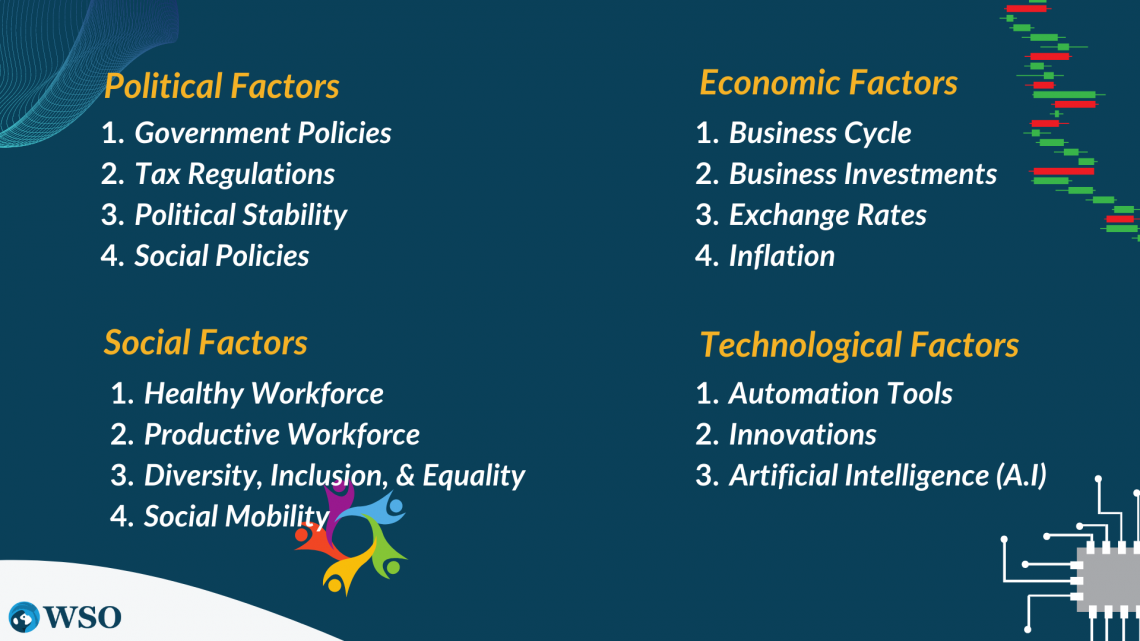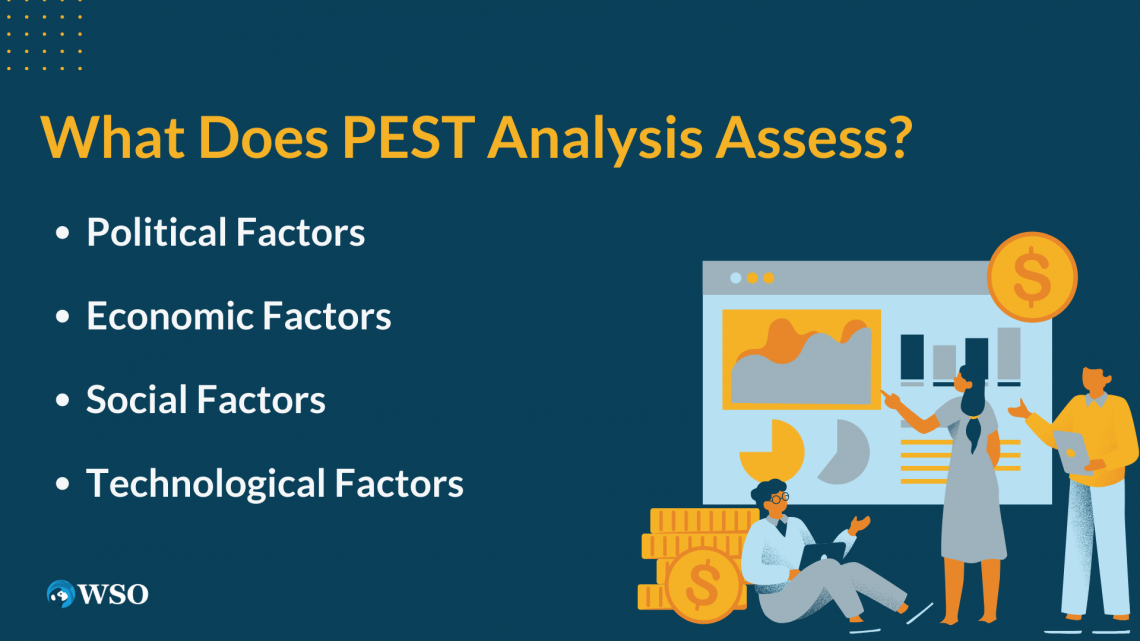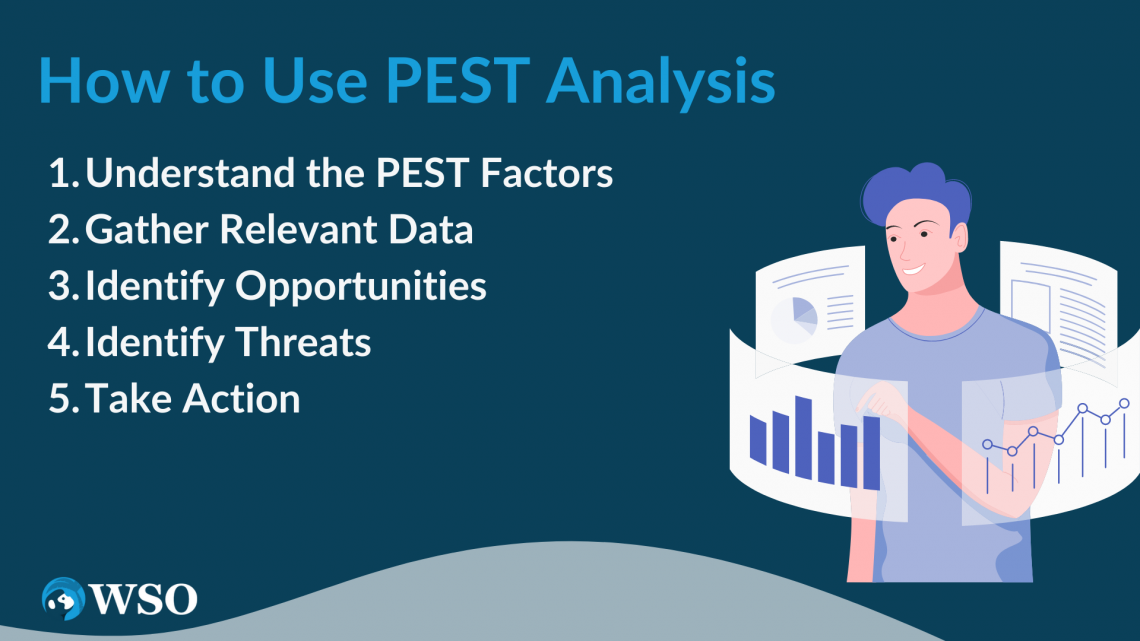PEST Analysis
A helpful management tool that can assist businesses in comprehending the outside variables that may have an impact on their operations.
What Is PEST Analysis?
PEST analysis is a helpful management tool that can assist businesses in comprehending the outside variables that may have an impact on their operations. This article will give a general overview of this analysis, describe how to use it, look at some business applications, and go over what it evaluates.

Political, Economic, Social, and Technological is the abbreviation PEST. These four variables are used to assess an organization's operating environment.
An organization can establish plans to address these issues by doing a PEST study to identify potential opportunities and threats. This can assist firms in identifying opportunities and dangers as well as predicting changes to the external environment.
Organizations can create strategies to adapt to changes in political, economic, social, and technological aspects and gain an advantage over the competition by identifying prospective changes in these factors. It can also be used to evaluate various markets and sectors.
Organizations can better understand the dynamics affecting various markets and industries by doing a PEST study on these markets and industries. It assists businesses in deciding whether to expand their operations in already-existing markets or enter new ones.

Sociological factors such as demographic changes, cultural trends, and consumer attitudes can have a significant impact on demand for particular goods and services, which are important for the firms to take under advisement during the planning of the manufacturing of the products.
Recognizing these trends early can help companies change their strategies and products to stay ahead of their competitors.
Technological advancements can also have a significant impact on businesses. They can improve efficiency and competitiveness by keeping up with the latest technology trends and incorporating them into the firm's operations.
The rise of e-commerce and online shopping has changed how businesses operate and interact with their targeted market. By conducting a PEST analysis and considering technological factors, companies can identify new opportunities for growth and innovation.
Organizations should proactively review these items and adapt to developments that may affect their operations.
Key Takeaways
- PEST Analysis evaluates the Political, Economic, Social, and Technological factors that can impact a business's operations and environment.
- PEST Analysis helps organizations identify opportunities, threats, and emerging trends in their industry, aiding in strategic decision-making.
- PEST Analysis is crucial for risk management, enabling companies to prepare for disruptions and mitigate potential hazards.
- This tool is widely used in market research, competitive analysis, and strategic planning to gain a competitive advantage.
- PEST Analysis should be used in conjunction with other strategic management methods, such as SWOT analysis and Porter's Five Forces, for a comprehensive assessment of a business's external environment.
What Does PEST Analysis Assess?
PEST analysis is a strategic tool organizations use to assess the major areas of influence that affect their sector and themselves.

By evaluating the environment, organizations can develop effective strategies to maximize opportunities and minimize threats.
1. Political Factors
- The political aspect of PEST Analysis examines the impact of government policy and legislative changes on the economy, industry, and organization. Tax and employment laws are key policy areas that can affect an organization's operations.
- The overall political climate of a region and international relations can also influence the organization's success.
2. Economic Factors
- The economic part of PEST Analysis focuses on key factors such as interest rates, exchange rates, economic growth, supply and demand, inflation, and recession.
- Analyzing these factors helps organizations make informed decisions about investment, expansion, or contraction.
3. Social Factors
- The social factors that may be included in a PEST Analysis are demographics and age distribution, cultural attitudes, workplace and lifestyle trends, and other societal factors that can affect an organization's success.
- Understanding the trends can help a firm with products and services that meet the needs and preferences of the targeted market.
4. Technological Factors
- The technological component of PEST Analysis has specific roles in developing technologies within the sector and organization, as well as wider trends and technological changes.
- Government spending on technological research can also be an important factor to consider. Organizations can identify opportunities for innovation and competitive advantage by analyzing these factors.
Note
It's important to remember that this analysis is only one method for evaluating the external environment of a business. This strategy should be used along with other strategic management methods, such as SWOT analysis, Porter's Five Forces analysis, and Competitive analysis.
How to Use PEST Analysis?
A popular strategic management tool, PEST analysis, enables companies to assess the influences that affect their operations. Organizations can apply this analysis to identify these factors and develop plans to mitigate the associated risks. To use this tool, we can follow this practice:

1. Understand the PEST Factors
- PEST analysis is a valuable tool used to analyze the macro environment of businesses. It helps in understanding factors and their impact on a company.
- PEST stands for political, economic, social, and technological factors. Each of these categories identifies forces that affect every business in different ways.
2. Gather Relevant Data
- Further, we gather as relevant data as possible on the business environment. This can be done by analyzing competitor data and understanding their selling points, complications, and areas they need to improve.
- This provides an overview of information related to strengths and weaknesses.
3. Identify Opportunities
- Once you have gathered all the necessary information, evaluate it and identify any opportunities these changes can bring.
- Conduct a SWOT analysis to determine opportunities in new markets, help develop new products, or make processes more efficient.
4. Identify Threats
- It is important to determine if any changes in the environment are undermining your business.
- It also allows you to prevent problems or reduce their intensity.
5. Take Action
- Now that opportunities and threats are identified, it's time to take appropriate steps and measures to eliminate or manage them.
- Include the opportunities in your business plan and take steps to mitigate any threats that could impact your business.
6. Continuously monitor and update
- The macro environment is constantly changing, and it's important to keep track of these changes and how they may affect your business.
- Regularly updating your PEST analysis can help you stay ahead of any potential threats and take advantage of new opportunities as they arise.
Note
The analysis also helps companies identify new trends and changes in their external environment.
PEST Analysis & their applications in Businesses
PEST analysis has a wide range of applications in business. It helps you identify opportunities and risks, develop strategies, and make well-founded decisions in business life.

This analysis is used for business planning, market research, risk assessment, and product development.
1. Market Research
- It is a common tool for conducting market research when assessing factors that may affect a company's operations.
- By identifying the political, economic, social, and technological variables, which also allows a firm to understand markets, a firm makes decisions about things like its products and services with the help of evaluating these variables.
2. Risk Assessment
- This analysis helps identify possible dangers and opportunities in the company's environment.
- For example, companies operating in highly regulated sectors may use PEST studies to assess political factors that may affect their operations and to develop risk mitigation plans.
- We can also use it as a strategic planning framework which helps with long-term goals and objectives for a company.
- By assessing the factors that can affect the business, companies can develop strategies to adapt to changing environments and maintain competitive advantage.
4. Competitive Analysis
- It helps organizations assess competitor activity and market conditions.
- Companies can gain insight into their competitive strengths and weaknesses by examining the factors that affect their competitors and plan to gain a competitive advantage.
5. Investment Decisions
- We can use it to assess factors that might influence the company's desire to make business investments in the markets for future growth.
- Investors can make informed investment decisions and manage investment risks by evaluating the political, economic, social, and technological aspects that may affect the company.
6. Business Growth
- We can utilize this approach to analyze factors that could potentially impact a firm's decision for future growth and expansion in new markets.
- Companies can choose the best way to enter new markets by identifying and evaluating political, economic, social, and technological variables.
Note
Pest evaluation is a framework for reading outside elements which could affect your business.
Importance of PEST Analysis
Companies gain insight into market trends, competitiveness, potential opportunities, and threats by analyzing political, economic, social, and technological factors.

Information like this can be used to make strategies to make more informed decisions and stay ahead of the competition. There can be several reasons why this analysis can be important for an organization.
1. Risk and Opportunity Identification
- It helps organizations identify threats and opportunities.
- Companies can better seize new opportunities and counter potential threats by understanding the political, economic, social, and technological issues affecting the industry.
2. Strategic Planning
- This evaluation facilitates agencies to apprehend better the outside elements which can affect their commercial enterprise and use them in their strategic planning.
- Decisions regarding product development, market entry, and corporate strategy may be influenced.
3. Risk Management
- It can be used by businesses to identify and mitigate potential hazards.
- Organizations can develop contingency plans to reduce risk and protect against potential disruptions by recognizing factors that can affect operations.
4. Competitive Advantage
- Helping companies understand the environment in which they operate can provide a competitive advantage.
- This helps us make decisions regarding pricing, marketing strategy, and product differentiation.
5. Adapting to Change
- This analysis helps companies adapt to changes in the external environment.
- By understanding the political, economic, social, and technological issues affecting the industry, companies can plan to adapt to change and stay competitive.
6. Improved Decision Making
- Greater entire know-how of the outside surroundings wherein an employer operates facilitates an employer to make higher decisions.
- This helps in evaluating joint ventures, investments, and other strategic decisions.
Note
Companies must be proactive about transformative change in the fast-changing machinery industry.
Conclusion
Pest Analysis is a useful tool for companies wishing to understand influences on their operations. Companies can systematically assess political, economic, social, and technical issues to get a comprehensive overview of their business environment and make strategic decisions.

Various applications can be considered in various industries and fields. For example, we can use it to assess the market for new goods and services and factors affecting the performance of current goods and services.
Also, companies can use it to assess external factors that have a widespread impact on the sector and to identify emerging trends that may affect the future.
The ability to identify anticipated opportunities and threats and generate responses to those factors is one of the main benefits of this analysis.
Companies could gain a competitive advantage, and it could help them for long-term success by taking a proactive approach to understanding their business environment.
Another important thing to remember is that analysis is just one tool in strategic management. Likewise, it's important to remember that analytics is just a strategic management tool. It's not the only decision-making method, so it should be used in conjunction with other analytical methods.
Analytics is useful for companies navigating a rapidly changing and challenging environment. This technology enables companies to fully understand their work environment, make smarter decisions and stay competitive.




or Want to Sign up with your social account?